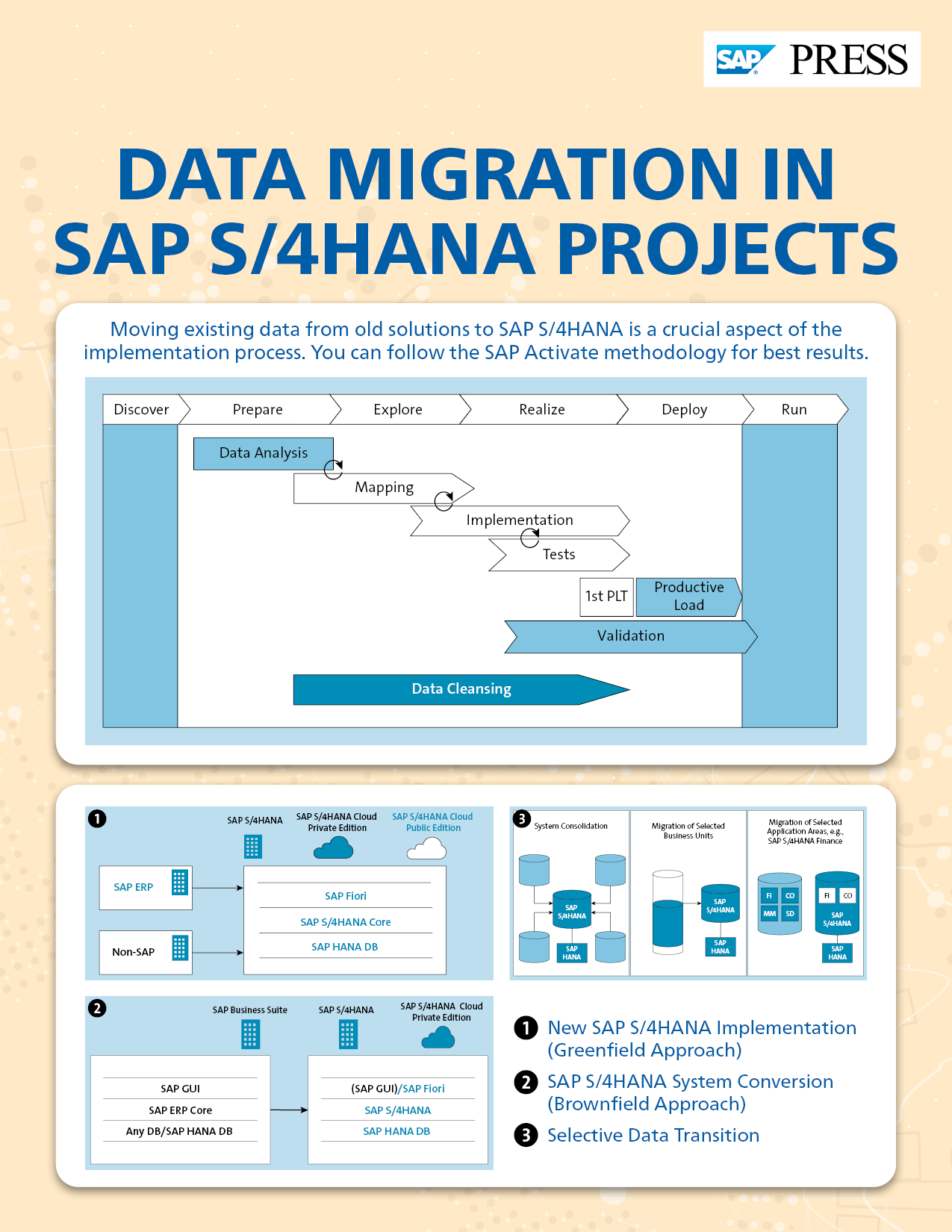Most SAP customers will remember that SAP initially had a 2025 deadline to migrate from SAP ECC to SAP S/4HANA.
However, backlash caused this date to slip to 2027. With that deadline now fast approaching, the task of migrating to SAP S/4HANA still remains as difficult. It is imperative that customers start thinking about the different migration scenarios now—if they have not already. This is not a small task but rather a monumental one that will require careful planning, expertise, and testing to complete. The whole process may take two years or more from the planning stage to completion of the migration. By starting now, this will allow customers ample time to migrate, test, and familiarize themselves with their new SAP S/4HANA environment.
You may be wondering what options you have when moving to SAP S/4HANA. Let’s look at the pros and cons of each.
New Implementation (Greenfield)
A greenfield implementation is essentially a fresh install of SAP S/4HANA on new infrastructure. Customers who are on legacy SAP applications may find that a greenfield implementation will fit their needs.
Here are a few advantages of a greenfield implementation:
- Customers may continue to run operations on a day-to-day basis on the legacy system until the new implementation is complete.
- The new implementation can be specifically tailored to fit your business needs. This includes things such as process, system, and resource configurations.
- Customers can still run their business and familiarize themselves with new SAP S/4HANA without disrupting legacy systems.
From a business and process perspective, the advantages with a greenfield approach may make sense. However, there are disadvantages to be aware of when heading down this road:
- The greenfield implementation approach is time consuming. Please understand that this will be a brand-new environment built from scratch; a clean slate. Everything will need to be thought out and designed accordingly. It may take much longer than if a customer were to upgrade an existing SAP ECC system to SAP S/4HANA. However, there are exceptions to this, and many variables to take into account, that may affect the amount of time it takes to perform a new implementation of SAP S/4HANA.
- The higher cost of implementation may be a product adoption barrier for some customers. In addition to maintaining old SAP systems and infrastructure, the new infrastructure will need to be deployed, and both will need to be maintained in parallel. This may stretch thin an already busy SAP team.
- Your team will need to get up to speed and become familiar with a brand-new system and processes. This may cause issues as there may be a huge learning curve moving from, for example, an SAP R/3 4.6C system to the latest and greatest SAP S/4HANA system.
If this sounds like something that fits your business scenario, you should start planning immediately as, again, this is a very time-consuming process.
Converting to SAP S/4HANA (Brownfield)
As with the greenfield approach, a brownfield approach will also take a lot of time to complete. The difference is that instead of a brand-new system and infrastructure, customers will be migrating their current SAP ECC system to SAP S/4HANA. Here are a few advantages associated with a brownfield migration:
- You do not need to fully stand up in a new environment. Everything will be completed on your current landscape. This means, you may continue to work on your current SAP ECC system while the migration takes place in the background. Since this is the least disruptive option, it is the most popular option for customers migrating to SAP S/4HANA.
- You may keep some of your business processes and custom code in place and migrate them over to SAP S/4HANA. This will also mean less work, planning, and training required, as users will not need to learn entirely new processes like in a greenfield implementation.
- In addition to keeping current business processes and custom code, a brownfield migration will allow customers to adopt new SAP S/4HANA features if they so choose.
- Like the greenfield approach, a brownfield migration requires an extensive amount of time from start to finish, but it will go much faster than a greenfield project, all the while being cheaper.
There are also some disadvantages of a brownfield implementation:
- Not everything will translate over during the migration. This may require extensive knowledge of your current system and SAP S/4HANA to recreate processes and recode.
- Working with legacy, unoptimized, or poor code will slow down development significantly.
- You will encounter technical issues that may halt your brownfield migration in its entirety. Expect that this will happen and plan accordingly.
Hybrid Approach
A hybrid approach is a mix of both greenfield and brownfield implementations. Essentially, day-to-day business is run on the current SAP ECC environment while a new installation of SAP S/4HANA on new infrastructure happens in the background. You will maintain both environments and migrate data you want to keep from your legacy system to your new system afterwards. There are variations of this, but for the most part, a hybrid approach will be a mix of both greenfield and brownfield approaches.
How Does RISE with SAP Fit Into This?
As hyperscalers such as AWS, Azure, and Google Cloud Platform are starting to be widely adopted, we're seeing businesses asking if RISE with SAP is the right move? The answer is it really depends. Moving to RISE with SAP means the customer will lose control of the infrastructure side of things, as SAP will be responsible for this piece. SAP’s push to move to the cloud (via SAP Business Technology Platform and RISE with SAP) is to move forward with a simplified data model, reduce fragmentation of databases, and release levels. Customers will need to ask themselves if moving to RISE with SAP will be cost prohibitive? Will the business disruptions be too much? Will it integrate with other applications? Will moving to RISE with SAP help solve current and future challenges? RISE with SAP is not for everyone. These are some of the questions that customers must ask themselves during their technical journey into the cloud or SAP S/4HANA.
Is the Public Cloud the Future?
Even though SAP moved the original SAP S/4HANA deadline from 2025 to 2027, they are unlikely to move the goalposts again. As you start the planning phase of your SAP S/4HANA migration it may be advantageous to start thinking about migrating from your current on-premise solution to the public cloud as well.
Of course, there are many considerations that need to be taken into account when making that decision such as cost, scalability, security, and architecture, just to name a few. For the most part, cloud infrastructure is more cost effective than on-premise infrastructure, but there definitely are exceptions to this. Businesses can reduce the costs associated with on-premise infrastructure, software, and hardware, and increase flexibility and scalability by moving to a pay-per-use model. The scalability and flexibility of the cloud allow the removal, addition, and spinning up of resources as necessary to fit business needs.
In addition to this, you will also need to take a look at how automations and observability will fit in with your current and future landscape. During the highly technical journey of an SAP S/4HANA or cloud migration, your SAP Basis expert cannot be everywhere all at once. This is where consultants like Avantra could come in and provide a full suite of features to reduce, streamline, and enhance your technical processes. Landscapes will still need observability and automations in place of redundant tasks as you plan your migration to the cloud and/or SAP S/4HANA.
Free Up Your Team’s Time with the Avantra Observability and Automation Suite
With the looming SAP S/4HANA deadline, and ever-increasing responsibilities put on technical teams, the Avantra Automation and Observability suites can help teams maintain deadlines efficiently. It comes as no surprise that the SAP S/4HANA migration is an extremely technical journey. This means a large amount of time will be spent going over documentation, migration, and cutover exercises.
While your greenfield or brownfield implementations are ongoing, legacy systems will still need to be refreshed and monitored accordingly. Tasks such as system refresh can take days (if not more) to complete across multiple systems. With the Avantra automation engine, refreshes can be hands off and started with a click of a button. Avantra offers other automations such as Start/Stop SAP to save on cloud costs (should you decide to move to the cloud), SAP Kernel Update, and SAP HotNews Analysis to view applicable SAP notes and apply them directly.
Avantra also offers observability with end-to-end monitoring, prebuilt checks, custom checks, notifications, predictive analytics, and machine learning. With Avantra monitoring your landscape and kicking off automations, rest assured you can focus on bigger more important projects, such as migrating to SAP S/4HANA or the cloud.
This post was originally published 3/2024.






Comments